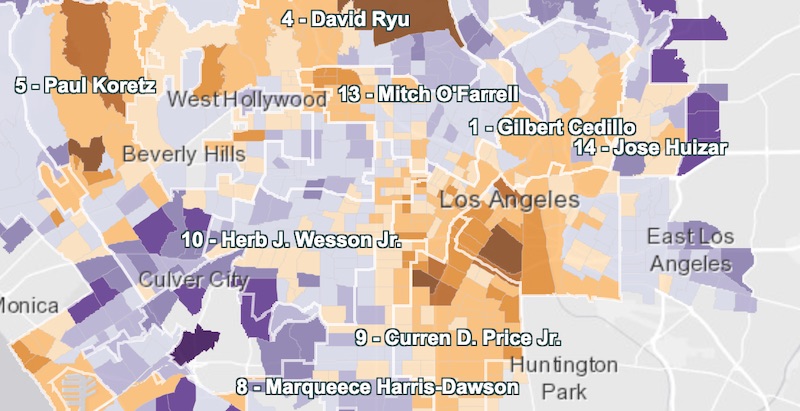
Want to see the self-response rate to the 2020 Census in your neighborhood? The U.S. Census Bureau updates the results each day, then the state’s Statewide Outreach and Rapid Deployment (SwORD) team uploads them to this map, where they’re divided by census tract.
By now, you’ve probably seen several reminders to complete your census, or perhaps a census worker has even knocked on your door. If you haven’t filled yours out already, you can do so online in less than five minutes. Just go here or call 1-844-330-2020.
After that, you may find it interesting to see how self-reporting is going in your neighborhood. The map divides Los Angeles by district, listing each district’s number and its city councilmember, then by census tract. If an area has a high percentage of self-reporting, it’ll be purple. If not, it’ll fade to a rust color. For example, Census Tract 4806 near South Pasadena has a 2020 self-response rate of 76.1%, which is 5% higher than the last census in 2010. Census Tract 1901 in Hollywood is currently at 45.2%, compared to 56.3% in 2010.
As you browse, it’s worth noting that self-response rates are reported as a percentage of all housing units in a given tract. If a tract has a low population or a high rate of vacancy, like the tract that contains Griffith Park, it may seem like it has a disproportionately low response rate, even if most of its residents have responded.
Why is it so important to respond to the census? It’s designed to count the entire U.S. population. That count will determine how federal funding is split among states, counties, and communities. This is the money that pays for schools, roads, public transit, hospitals, and other public needs. The census also determines how many of the 435 seats in the U.S. House of Representatives each state gets for the next 10 years. If people don’t respond to the census, it could result in an undercount. And that could result in missing out on political representation or crucial funding. The census also affects redistricting, and how businesses decide where to open new locations.
Due to the pandemic, census field data collection, including door-knocking, was suspended in March. Initially, the Census Bureau had planned a delayed timeline, in which both self-reporting and field data collection would end on October 31. However, the Bureau later switched back to its original timeline, meaning the deadline is September 30—just a couple weeks away.
The City of Los Angeles and other entities filed a lawsuit against the Trump administration to go back to the extended timeline. Last week, that lawsuit moved forward and a federal judge ordered census officials to not wind down their counting efforts, according to LAist. But for now, plan to wrap up your census by September 30 to be counted.
Juliet Bennett Rylah is the Editor in Chief of We Like L.A. Before that, she was a senior editor with LAist and a freelancer for outlets including The Hollywood Reporter, Playboy, Los Angeles Magazine, IGN, Nerdist, Thrillist, Vice, and others.


